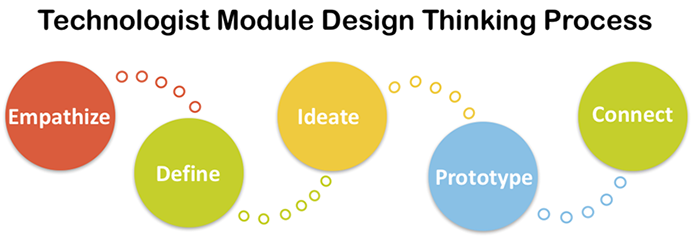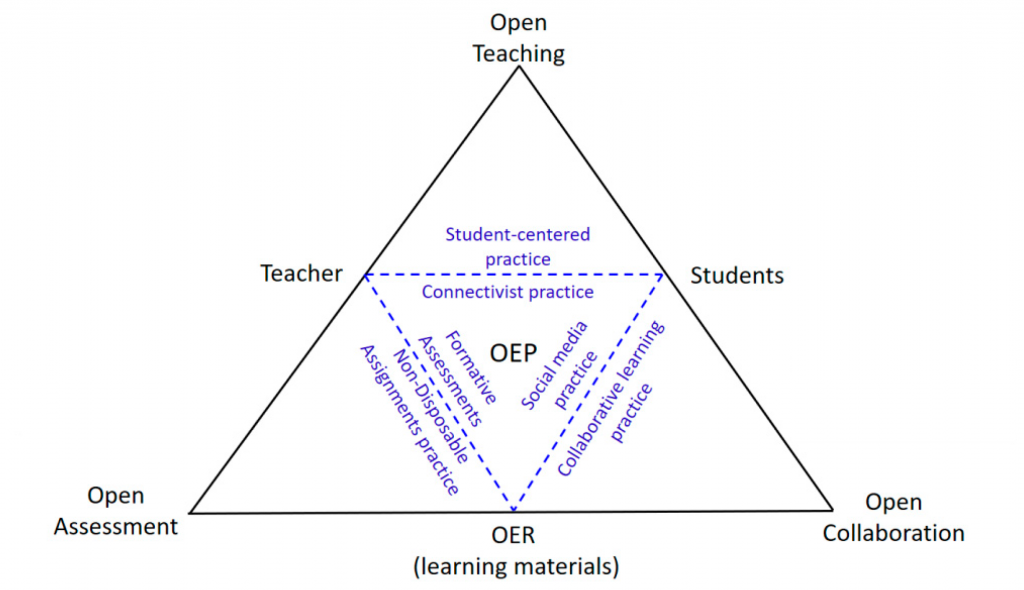Open Course Design & Assessment
Open Educational Practice Framework
Open Educational Practices (OEP)
In recent years, the enormous growth in the (re)use, adaption and creation of OER has prompted researchers to begin to shift their focus away from OER toward examining the teaching practices used to deliver open content called open educational practices (OEP) . During the COVID-19 pandemic, a group of scholars conducted a study to examine the impact of an intentionally designed OEP course that resulted in the development of a “Framework for OEP-based Course Design” (Zhang, et. al, 2020). This framework identifies three key dimensions of OEP:
- open teaching;
- open collaboration; and
- open assessment.
Within these three dimensions exist the teacher, student and resource connections that need to occur to effectively demonstrate OEP — each of which is enabled through the use of educational technologies. Technology enablers will vary from situation to situation — and will change as technology evolves.
How do I Choose “Technology Enablers?”
Explore the Ontario Extend Technologist Module Design – Thinking Approach.

“Technologist Design Thinking Process” by Joanne Kehoe is licensed under CC BY 2.0
Below, you will find a short description of each of the three dimensions of the “Framework for OEP-based Course Design” (Zhang, et. al, 2020). Each of these dimensions is explained in greater detail — with examples of how they can be applied within your teaching practice — in the remaining sections of this module.
Open Teaching (Teacher-Student Lens)
Open teaching implies that teachers will implement teaching methodologies that allow learners to actively contribute to the co-creation of knowledge and be self-regulated. Teachers can approach open teaching through connectivist learning practice — which is grounded in connectivism , a student-centred teaching and learning approach where learners share and co-create knowledge by making connections that can extend beyond the duration of the course.
Open Collaboration (Student-OER Lens)
Open collaboration implies that teachers will work with their students to build open communities to foster teamwork and social interaction (i.e., editing a blog, creating a Wikipedia page). Students work together through the co-creation or adaptation of OER and digital artifacts — and are encouraged to share openly with others. This can happen through social media platforms, Pressbooks, websites, ePortfolios, etc.
Open Assessment (Teacher-OER Lens)
Open assessment implies that teachers will redesign learning tasks to support both teacher — and peer — assessment and a strategy like this emphasizes reflective practice and improved learning outcomes. Indeed, adjusting and redesigning assessments to support OEP is essential. There are a number of technologies that can be used to support open assessment like OER authoring tools, OER repositories, social networks and collaborative editing tools. In these cases, students are assessed on collaborative, renewable assignments that are the result of the creation of supplemental learning resources that all students can benefit from (and that future students can build upon). Take for example open-class discussion forums that are established to create a space for students to discuss the feedback and answers to assessments and, by extension, to learn from each other.
The remaining sections of this module will take a deeper dive into each one of these dimensions of the “Framework for OEP-based Course Design.”
Framework for OEP-based Course Design
Note. This figure highlights the open educational practice framework. It illustrates the various ways in which the practices of open teaching, open collaboration and open assessment are connected in the overall picture of open educational practice.
Adapted from A Case Study of Applying Open Educational Practices in Higher Education during COVID-19: Impacts on Learning Motivation and Perceptions by Zhang, et. al, and is an open access article distributed under the terms and conditions of the Creative Commons Attribution (CC BY 4.0) license.
References
Zhang, X., Tlili, A., Huang, R., Chang, T., Burgos, D., Yang, J., & Zhang, J. (2020). A Case Study of Applying Open Educational Practices in Higher Education during COVID-19: Impacts on Learning Motivation and Perceptions. Sustainability, 12(21), 9129. doi:10.3390/su12219129.
Open Educational Resources. Teaching, learning and research materials in any medium – digital or otherwise – that reside in the public domain or have been released under an open license that permits no-cost access, use, adaptation and redistribution by others with no or limited restrictions.
A.k.a open pedagogy, OEP is the use of open educational resources (OER) to support learning, or the open sharing of teaching practices with a goal of improving education and training at the institutional, professional, and individual level.
The collective connections between all the ‘nodes’ in a network that result in new forms of knowledge (Bates, 2019).


